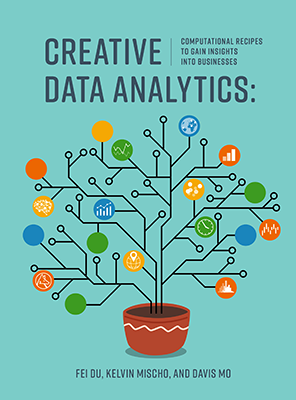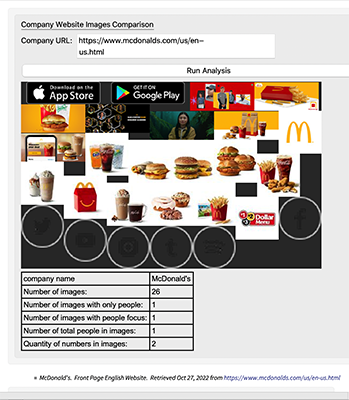
Sep 5, 2023 2023-09 Accountancy Faculty Student
New app-driven textbook unlocks the potential of data-driven storytelling
Fei Du, associate professor of accountancy at Gies College of Business, has created a groundbreaking new textbook that makes data analytics-driven storytelling more accessible to students.
Creative Data Analytics: Computational Recipes to Gain Insights into Businesses is a comprehensive, app-driven textbook that Du co-authored with Kelvin Mischo, an Enterprise Account Manager and Certified Mathematica Instructor at Wolfram Research (Champaign, IL), and Davis Mo, a student at Concordia International.

“Want to make something irresistible? Get to the fun part quickly,” said Du. “Our book is a simple and powerful tool students can use to quickly test their ideas and focus on the exciting takeaways and data insights they uncover. It empowers students to bypass the ‘academic choking’ of building code from scratch and apply a ‘computational recipe’ to a specific problem.”
Du added that although eBooks are not a new concept, she believes it is fair to say that this textbook, with each chapter a de facto, user-friendly app, represents a breakthrough in the field.
Here’s how it works: Students can input their own data, often as easy as providing a web URL, and then click "Run Analysis" to see instant results. This unique approach sets it apart from traditional eBooks and offers students an interactive and dynamic learning experience.
In a website analytics chapter, for example, the book delves into an analysis and visualization of McDonalds’ global marketing by country. By utilizing deep learning algorithms, it identifies objects in images based on consistent criteria and then combines these images into a single visual representation.
The visual showcases how each country prioritizes its content, with some placing more emphasis on products and coupons, while others focus more on customers and employees. This comprehensive approach offers valuable insights into McDonalds’ marketing strategies across different regions. Although the tools are pre-calculated, learners can enter new data and run an analysis with new results.
Du said she wrote this book, in part, to a younger version of herself who struggled with data work during her graduate studies.
“While there are specialized software packages available for each data type, I wished for a one-stop solution that could help me leverage multiple data types in one software environment,” said Du.
When she began teaching data analytics at Gies Business in 2017, she noticed that her students were also frustrated by being required to make multiple cognitive jumps simultaneously, such as understanding the subject topic, comprehending the data, and the coding used in analysis.

“Students are more interested in the data implications of diagnostic analytics or predictive analytics, rather than learning about statistical distributions, theorems, or linear regressions,” said Du. “In essence, our goal was to make coding and data acquisition easy, while also ensuring impactful visualizations and interesting data insights.”
In 2019, Gies’ Executive Associate Dean of Faculty and Research Mark Peecher started Du on her journey to create a teaching solution in collaboration with Wolfram Research. When asked in 2020 to host a Gies webinar on the tone and content of earnings calls in the wake of the COVID-19 pandemic, she used that platform to develop the first computational recipe in the book and laid the foundation for each of the book’s modules.
“This book blends together embedded apps for live computation, equivalent coding examples that require no prior coding experience, and a narrative for applying modern computation to business analytics,” said Wolfram’s Mischo.
Du calls the interactive modules a test kit for understanding corporate genes, values, culture and strategies: Tools assess the text, image, structure, and diversity of imagery on company websites; the complexity, sentiment and linguistic style of corporate disclosures; and competitive analysis of customer complaints, reviews, and profitability. All data used is in the public domain.
Du added that a ChatGPT plugin has already been incorporated into the book, making it easier revise coding with minimal effort and cost. In addition, this project aims to teach students computational thinking skills and how to approach problems algorithmically.
“Computational thinking is a versatile and transferable skill,” said Du. “Once students grasp the fundamentals, they can leverage this knowledge to enhance their interaction with GPT and easily extend it to other business contexts.”
Du believes that as businesses and educators begin to rely more on artificial intelligence, it’s important for students to learn how to ask the right questions and apply their critical thinking to algorithms used for data storytelling.
“Understanding how to supervise AI content, not just write code, will give our researchers and graduates a big advantage,” said Du. “More importantly, it is crucial to clarify to students that the fear of vulnerability to AI-related technology is unfounded. For example, despite IBM's Deep Blue defeating a chess grandmaster in 1997, humans have not lost interest in the game. AI now serves as a valuable trainer, aiding human players through affordable AI-based chess programs. We should leverage AI's power to improve our own job performance, especially AI’s practical application in real-world accounting and business scenarios.”
“We humans might turn into curators or taste makers of code -- the final sanity checkers --instead of the worker bee writers of it,” said Wolfram’s Mischo.
Du will begin using the textbook this fall in Business Data & Innovation (BDI) 513: Data Storytelling, which is part of Gies’ masters programs in business analytics, technology management, and management. Other universities have also expressed interest in incorporating it into their data analytics curricula.
